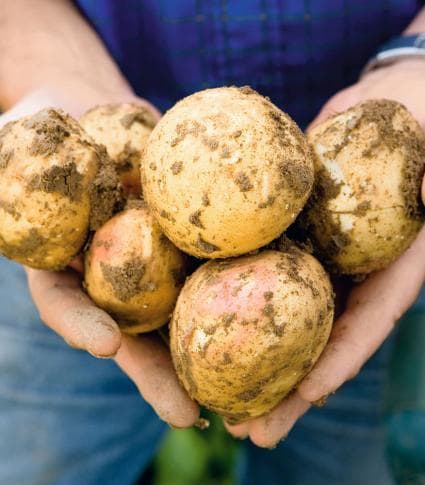
Innovation and Collaboration
Building Global Food System Resiliency
This essay by Dr. Philip Miller is adapted from Biotechnology in the Time of COVID-19, compiled by Dr. Jeremy M. Levin, and is printed with permission from RosettaBooks. The book highlights a collection of diverse viewpoints from more than 45 thought-leaders in the biotechnology industry and their organizations’ efforts to battle the COVID-19 pandemic. Check your Amazon Kindle store to download a free copy between June 8-12. U.S. readers can download here: https://www.amazon.com/Biotechnology-Time-COVID-19-Commentaries-Front/dp/B08DL9MS8C/ref=sr_1_1?keywords=Jeremy+M.+Levin&qid=1664288497&s=audible&sr=1-1
#BiotechnologyCOVID19
In May 2020, amid the global COVID-19 pandemic, two mothers go to their local market to buy groceries for their families, as they have so many times before. One is an urban dweller in the Northeast United States and the other lives in a small farming community in Kenya.
The American shopper finds that her grocery store is rationing beef, chicken, and milk among customers because of shortages — something she’s never seen. Several of the meat processing plants for brands that would have packaged and shipped meat to her grocery store before COVID-19 are closed because of outbreaks among their workers. The consumer dairy supply chain can’t keep pace with nationwide panic-buying of milk, among other household staples. At the same time, dairy farmers around her country are dumping an estimated 3.7 million gallons of milk each day because the schools and restaurants the supply was intended for are closed, and the commercial dairy supply chain is unable to pivot production to accommodate consumer-grade products. Infrastructure and labor vulnerabilities in a food supply chain that she had hardly considered have been exposed by the health crisis.

However, the Kenyan shopper knows before she arrives at the market that she could be returning home empty-handed — because she knows her supply chain personally. Since January her neighbors’ produce farms and pastures meant for cattle grazing have been ravaged by the largest locust invasion that Kenya has seen in seventy years. By February, 200 billion locusts across East Africa were consuming nearly 400,000 tons of food per day,the equivalent of what eighty-four million people eat in a given day. Because neighboring farmers were already in crisis without access to a pesticide that could control the swarms, the spread of COVID-19 has thinned the local food supply even further as distancing measures and illness brought much production and distribution to a halt. When she arrives, she finds that the limited local supply has led to a price increase for what foods are available—and what she can afford to buy for her family won’t last as long as she needs it to.
Innovation access, labor availability, the nature of national policies and regulatory systems, and food movement infrastructure are largely unseen forces that propel our food supply at the global level and hinder it regionally where shortcomings exist. The COVID-19 pandemic has forced the food and agriculture industries to accelerate conversations and collaborations that will lead to the solutions we need to make our food supply more resilient for all people. And I believe that the role of innovation companies both in convening public and private stakeholders and leveraging scale to positively affect the sustainability of global agriculture has never been more important.
Leading global government relations and regulatory policy for Bayer’s crop science division, I work with experts at companies, institutions, and governments on macro issues like these that impact ag technologies. Bayer sells seeds and products that help farmers grow food despite pressure from pests, disease, weeds, and mounting climate volatility. Nearly thirty years ago, I began my career as a biochemistry and molecular biology Ph.D. working on discovering and developing those products in the lab. I would have told you then that the speed of innovation was always going to be key if we were going to be able to produce enough for more people using fewer of our constrained natural resources. What I didn’t know then, and have learned from my years spent outside of the lab, is that the speed of innovation isn’t usually the problem — instead, it’s getting innovation into the hands of the people who need it.
I’ll give you an example. Fall armyworm (FAW) is an insect pest capable of an incredible amount of damage because it reproduces quickly and can spread long distances rapidly. In production agriculture, it’s been a particular problem for maize. More than two decades ago, markets including Brazil and the US adopted Bt maize, a crop that’s been genetically modified to contain a naturally occurring soil bacterium that controls pests. Outside of the agronomic and economic benefits growers in these countries have seen, preventing FAW from feeding on crops also has a food quality benefit for consumers. These pests can increase the infection of mycotoxins in grain, which can lead to aflatoxins—a known carcinogen for humans. Since 2016, FAW has spread through Africa and Asia, but, because genetically modified crops have not yet been approved by policymakers in most countries in these regions, growers have a limited capacity to slow what is truly preventable damage. Based on 2018 estimates, every year up to 17.7 million tons of maize are lost to FAW in Africa alone. This amount of maize could feed tens of millions of people, and represents an economic loss of up to $4.6 billion.


When policies are not science-based and infrastructure is weak, the people who already had the least food security often suffer most. The FAO estimates that by 2050, the world will need to produce approximately 50 percent more food and livestock feed to accommodate population growth and changing diets.[1] We’ve yet to innovate to match the challenges we face, but I believe we will. The latest advances in data science, predictive analytics, and biotechnology in particular make me excited to imagine what we will accomplish. If precedent holds, though, the larger question will be our ability to deliver that innovation to growers who are hungry for answers, figuratively and literally.
At Bayer, we align ourselves to the global mission of “Health for All, Hunger for None.” This ambitious mission is grounded in our core disciplines, health care, and agriculture, and is conceivable only based on our global scale and ability to collaborate with bright minds beyond our walls. Some segments of society have developed a mistrust for the private sector, and particularly large multinational companies. But in the past few months, I’ve seen countless companies like ours lining up alongside health care professionals to directly meet immediate COVID-19 treatment needs — and farmers, food chains, NGOs, and governments to deliver innovative solutions to make our food supply more sustainable and reliable around the world. I’ve seen scale applied for the greater good.
Consider the work we’ve done to connect farmers more directly to retailers in the food supply chain, particularly in the developing world. What we’ve seen during COVID-19 is that growers who were better connected and trained in digital resources in countries including Ecuador and India are more easily selling their harvests and maintaining their operations during the disruptions in the supply chain caused by the pandemic.
We’re using our worldwide presence to spot potential emerging threats to food security and leveraging our scale to help. We are working with a consortium of experts to solve the Tropical Race 4 (T4) disease crisis in the global banana crop, which threatens the economic and food security of millions in the developing world. We’re working with distributors and food retailers to ensure that supply lines remain open and responsive. We’re creating strategic stockpiles of seed and crop protection products in key locations for rapid deployment as needed. The COVID-19 crisis has reminded us that our highly interdependent, yet disparate, the food system needs to be ready to weather the challenges we can anticipate, and also those we cannot. Creating a more resilient food system requires a concerted, collaborative, and global effort to strengthen our food system against external threats. Improving agricultural sustainability and supply chains will help us withstand and respond to future crises.
Every advancement in agriculture has come about because of a deeper understanding of science and a commitment to delivering innovation. It’s my hope that coming out of a time when science and data were key focal points of our daily existence, we can develop a newfound, healthy trust in science and the entities that pursue it within our society. What if we continued to make decisions based on data and the counsel of experts in their fields? What if we rejected sources of misinformation as threatening to the public good in all areas of our lives, and our policymakers did as well? What if we imagined the experiences of the mother accustomed to a bare market or the grower fighting to keep his small grove of trees alive as we shaped our opinions about the technologies that enable better systems of agriculture? What if we maintained the ethos of empathy we’ve developed for our fellow man in far corners of the world through this historic shared experience, and realized ways we can all contribute to Health for All, Hunger for None? We can, and we should. And you can count on companies like ours to be endeavoring to do so along with you.
Dr. Philip Miller is a senior vice president at Bayer where he leads global agricultural government relations and regulatory policy for the company’s Crop Science Division. As chair of the Biotechnology Industry Organization’s food and agriculture section, Miller leads a diverse community of stakeholders to develop and advocate for global agriculture policies that will help feed a growing population. He also serves on the Crop Life International strategy council and on advisory committees for the USDA, NIH, and the National Academy of Sciences.
- [1]Food and Agriculture Organization of the United Nations 2017 (FAO Global Perspective Studies)









